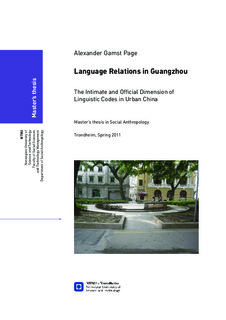| dc.description.abstract | This thesis is based on fieldwork conducted in Guangzhou, one of China’s major urban areas. The city, as well as the Guangdong province of which Guangzhou is the capital, is associated with the dialect or language called Cantonese, made known in the west through Hong Kong cinema. The national language, Mandarin, is also widely spoken, and the disparity between these two languages are my major focus. Much of my time was spent at Karen’s Place, a souvenir shop near the American consulate on the island of Shamian. Here, and elsewhere in Guangzhou, I study how the use of the local and the national languages both affect and are affected by the situation wherein they occur. My argument, while anthropological at core, utilizes much research from sociolinguistics as well as the terminology thereof.
There are nine major language groups in China, and while these are mutually unintelligible, they are nevertheless officially regarded as dialects of Beijing Mandarin. In Guangzhou most people speak both Mandarin and Cantonese, at least to a reasonable standard. My observations suggest that these languages have become hierarchically ranked along two axes, one of respectability, one of intimacy, and so may be said to comprise an official/private division. These axes vary in indirect proportion to each other, so that while Mandarin gives the speaker an air of respectability, Cantonese inspires more empathy. When English is used, such as was often the case in Karen’s Place, the linguistic situation is further complicated with the introduction of a third language. The customers at Karen’s Place were sorted into categories according to what language they used, which had an impact on the treatment they received. I hold this to be comparable to Sahlins’ various levels of reciprocity, as intimacy affects economic behaviour, but must be seen within a framework of guanxi, an informal network of reciprocal relationships in Chinese communities.
In many social arenas, language use is situationally determined, for instance, Mandarin should be used in official settings and when addressing police officers and such. Part of this thesis extends beyond Shamian where I discuss the consequences of using the wrong language in a given situation, particularly when one uses the intimate language, Cantonese, in an official situation. This is an example of marked language, i.e. the use of language in a noticeable way attracting attention and eliciting a stronger response than unmarked. Marked language in such cases creates what might be termed cognitive discomfort, which may be resolved with either acceptance or rejection of the marked interaction, which I in turn explain with recourse to Leon Festinger’s theory of cognitive dissonance. | nb_NO |
